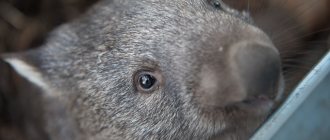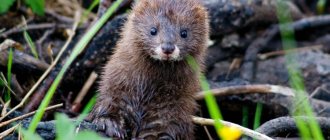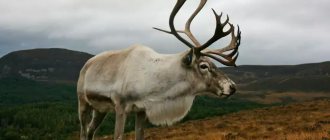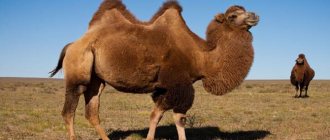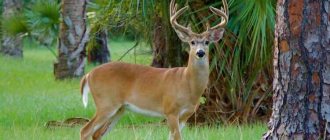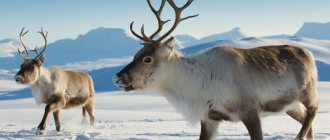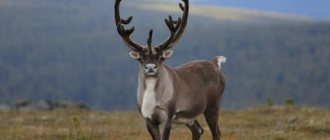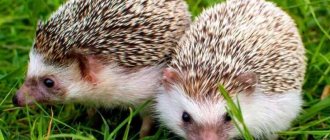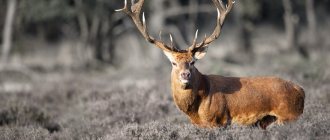- Wild animals
- >>
- Mammals
An animal such as a fallow (lat. Dama) belongs to the deer family. Therefore, it is not surprising that sometimes you can find information about it not only as about the European fallow deer, but also as about the European deer. We must keep in mind that these are the same animal. And the word “European” is added due to the fact that fallow deer today are often found on the European part of the continent. Although this animal also lives in Western Asia.
Description of the doe
In size, fallow deer are larger than roe deer, but smaller than red deer. The body length of the European subspecies is 130-175 cm, the tail length is about 20 cm, the height is 80-105 cm. The weight of males is in the range of 65-110 kg, for females 45-70 kg. The Iranian fallow deer is slightly larger in size; the body length of males of this subspecies reaches 2 m. The fallow deer has a muscular build, a short neck and limbs compared to the deer. The horns are spade-shaped. The fallow deer is colored differently at different times of the year. In summer, the upper body and tip of the tail are reddish-brown with white spots. The lower body and limbs are light. In winter, the head, neck and ears become dark brown, the back and sides are almost black, and the belly is ash-gray. There are individual individuals painted black or white.
Connection with other words
Words containing -lan-:
- messenger
- malanya
Words starting with doe:
- Lanling
- Lanlinskaya
- Lanling
- Lanling
- lantian
- Lanzhou
Words ending with -lan:
- hand
- Elan
Hypo-hyperonymic relationships
group totality system organism animal deer fallow deer
What kind of doe is there (adjectives)?
Selection of adjectives for words based on the Russian language.
golden tremulous frightened small frisky spotted hunted timid white running wild fleet-footed fast wounded timid forest graceful gentle mountain killed fluffy young hunted sleeping pronghorn sacred dead meek tame frightened trembling poor sensitive frightened slender Orkney caught curious graceful magical silver yellow light-footed young aged starry cow red trembling blind oh light beautiful helpless running away wounded snow-white small red pursued dying tiny thin-legged long-legged magnificent
What can a doe do? What can you do with doe (verbs)?
Selection of verbs for words based on the Russian language.
nod appear turn shake smile scowl rush rush get out be silent stand show dive rush rise appear silent jump up look apply have time to stop sit rush watch die approach scare rise leave decide to follow disappear try to jump out stay put talk close fall break away talk think stand up stretch out quit flinch bend offer sigh raise hesitate see squeeze notice assure grin turn away slide persuade lower run do
Associations to the word Doe
forest hunter view cub shoulder estate labor tiger glade lion hand return fawn shore twilight tenderness table horror threshold interest ravine horn smile comparison thicket watering hole fear dinner high cost peace curiosity hatred neck daughter trap expedition cartoon door entertainment picture extreme eye tongue mirror grumbling name Harry Alexandrov moment strait zoo earth mistrust wanted doubt some hall cover lioness rise coal playground drive rock
Anagrams of doe
cash
Hypernyms for doe
- deer ruminant artiodactyl mammal
Scope of use of the word doe
General vocabulary Biology Hunting Zoology Idiomatic expression
Feeding characteristics of fallow deer
— Advertising —
The fallow deer is a ruminant herbivore. Its diet includes grasses and tree leaves. An animal may also tear off the bark of trees, but this does not harm the condition of the forests as much as happens in the case of deer.
The plants that fallow deer eat are determined by the time of year and their availability in certain areas. So, in the spring - these are snowdrops, corydalis, anemone, shoots of rowan trees, maples, oaks, pines and shrubs. In summer, the fallow deer's diet includes mushrooms, acorns, chestnuts, berries, sedges, cereals, legumes and umbrella crops. In winter, tree bark and branches are added. The fallow deer's mineral reserves are replenished on salt-rich soils.
In order to increase the fallow deer population in forest areas, people create special salt licks and place hay and grain in animal feeders. Even feeding meadows are laid out for fallow deer with clover, lupine, Jerusalem artichoke and other herbs.
Habitat
Mainly the European fallow deer lives in mixed and deciduous forests on the foothills and plains with a wide variety of vegetation and necessarily shallow snow cover in winter.
Usually grazing in small herds, during the daytime fallow deer wander through forest clearings and forest edges. They feed on herbaceous plants, young shoots and leaves of deciduous shrubs and trees. Fallow deer also strip bark more often than they can cause considerable damage to the forest.
The peculiarity and disadvantage of keeping fallow deer in a mild European climate is the need for feeding and protection from predators. Such constant care allows us to maintain a high density of this species almost everywhere.
In general, the European fallow deer demonstrates excellent adaptation to living in different climates (tropics and moderately cold). It can be said that the only factor that limits the migration of fallow deer to further northern areas is the depth of the snow cover, which is associated with unsuccessful cases of acclimatization in some places, for example, in the northern regions of Russia and the Scandinavian countries.
Distribution of fallow deer
During the last interglacial period, the fallow deer was found throughout Central and Southern Europe, but with subsequent cooling, its range was reduced to Asia Minor and northern Africa.
In ancient times, the inhabitants of Phenicia and Rome introduced this animal to the Mediterranean region, to countries such as Greece, Italy and Spain. Later, during the Middle Ages, fallow deer were also brought to England and the countries of Central Europe. In eastern Europe, the species is found in Lithuania, Latvia, Belarus, and Polesie. During the initial periods of introduction, fallow deer were kept in pens and then released into natural conditions. Fallow deer have been successfully introduced into North America, Australia, New Zealand, South Africa, Chile, Peru, Argentina, Japan and even the island of Madagascar. — Advertising —
But in their traditional range, fallow deer have become a rare species. In the 19th century they disappeared from North Africa, and a little later from Greece and Sardinia. The animal is also practically never found in its Asian range.
Fallow deer live in forests where there are many lawns and open spaces and are able to adapt to different living conditions. Fallow deer live in groups that include up to 80 animals.
Subfamily Muntjacs (Muntiacinae)
Muntjacs are the oldest deer. They live in the dense forests of Southeast Asia and are distinguished by their relatively small size, short horns and enlarged fangs.
Indian muntjac
Found in India, Sri Lanka, Tibet, southwest China, Thailand, Vietnam, Malaysia. Was brought to England. Inhabitant of various types of forests with dense undergrowth.
Indian muntjac (Muntiacus muntjak)
Body height is 50-57 cm, weight is about 20 kg. The horns, about 17 cm long, usually do not branch at the apex; the bases of the horns extend onto the facial part of the skull. Males have upper canines 2-5 cm long. The color of the coat is dark hazel on the back and almost white on the belly.
Muntjac makes loud, drawn-out sounds, similar to a dog barking. This is how he notifies others of his presence and readiness to repel rivals.
Giant muntjac
This species became known to science only in 1994. As the name implies, the giant muntjac is the largest representative of the genus: its height reaches 70 cm and its weight reaches 40 kg. The horns are quite large for this genus (up to 28 cm), and the shoots are unusually long.
The giant muntjac is an inhabitant of the highlands of Laos, Vietnam and Cambodia.
In addition to the two considered, there are about 10 more varieties of muntjac: Bornean, crested, Thai, Gonshan, Rizwa muntjac, Roosevelt muntjac, etc. Some of them are listed in the Red Book.
Common types of fallow deer
A subspecies of fallow deer, which is common in Western Asia, is the Iranian fallow deer (Dama dama mesopotamica).
It is larger in size than the European fallow deer; its antlers are also larger, but not as branched as those of its relative. Now this subspecies has almost disappeared from the face of our planet, found only in a small area in the south of Iran (Khuzestan), in two reserves in Mazandaran (northern Iran), in northern Israel and Iraq. But the original distribution area of the subspecies began in Mesopotamia and Cyrenaica and continued to Egypt and Cyprus. Iranian fallow deer live in open wooded areas. Today people breed these animals in zoos and parks in Iran, Israel and Germany. Individuals bred in captivity are then released into the wild, thanks to which the population is gradually restored.
Age determination
Typically, fallow deer are classified into four age categories: cubs, yearlings, adults and seniors. By the way a doe looks, you can determine which category it belongs to. Older animals are more well-fed and wider in the back. Older people have a longer muzzle. The spotted pattern is unique to each individual, but it does not help in open areas.
Baby teeth fall out after about 19-22 months. The full adult dentition is formed at 26-30 months, although the last third molar may appear at 3 years. Most wild fallow deer are no older than 12 years.
The size and shape of the horns also help determine the age of their owner. One-year-old individuals have simple projections, or spichakas. The ocular and supraocular processes are formed in two-year-old fallow deer, and the spades appear some time later. Very old males may have smaller horns and shorter tines.
Fallow deer behavior
In terms of lifestyle, the European fallow deer is similar to the red deer, but it is not so picky about living conditions, preferring mainly pine groves and park-like landscapes.
This animal is not as timid and cautious as its closest relatives, but at the same time very fast and agile, like deer. Due to its gullibility and lack of timidity, the fallow deer often lives in parks, next to humans, it is easy to tame and such a semi-tame animal will willingly take food from people’s hands. In summer, fallow deer live either alone or in small herds. The young animals of the current year of birth are located next to the females. Animals are usually active in the cool morning and evening hours, at which time they graze and go to water. When it gets hot during the day, fallow deer go to rest on beds located in the shade of bushes, not far from water bodies. Here you can escape both the heat and the midges. As winter approaches, fallow deer gather in large groups in which males live together with females. At this time, an incredibly spectacular event of these communities begins: tournaments and fallow deer fights, followed by “weddings.”
Respect for nature
The Doe House is also an educational center. In addition to free sightseeing tours, during the spring-summer season there are environmental classes for children of different ages; the program even includes lessons for children from three years old. In addition, Mospriroda employees organize interactive programs, holidays, quests, master classes, promotions and educational games in the enclosure complex.
The indoor walking gallery located on the territory of the complex is also an exhibition space: in thematic exhibitions that change every season, you can see photographs of animals taken in natural areas of Moscow by professional photographers. One of the current exhibitions is dedicated to the history of the enclosure complex. It contains the most interesting archival photos of the eco-center.
In the clearing near the gallery there are educational interactive stands. Here children can find out what the tracks of different forest inhabitants look like, compare the wingspan of the largest birds and the size of wild animals. Here, as well as in the forest part of the complex, there are animal sculptures made of wood. In the 1960s, a small wood carving workshop operated on the territory of the enclosure complex. Carvers made sculptures from wood obtained from sanitary felling of the forest park and decorated the territory with them. The tradition has survived to this day.
A careful attitude to the traditions of the past in the “House of Fallow Deer” is combined with concern for an environmentally friendly future: the complex is supplied with energy by solar panels. They are installed near the amphitheater. In order to use only an alternative source of energy without disturbing the biological rhythms of the inhabitants, in the evening the enclosure complex “House of Fallow Deer” is only partially illuminated: there are lamps in the entrance area, inside outbuildings and on the observation tower. And in winter, after the New Year, a collection point for New Year trees is set up near the entrance to the complex.
The enclosure complex “Dom Dom” is a place where you can spend time interestingly and comfortably. By the way, entry here is free for everyone.
Reproduction of fallow deer
The mating season for fallow deer is from early September to mid-November.
Males during this period begin to trumpet loudly, so they call on females and emphasize their rights to the previously occupied territory. To establish their territory, males dig small holes in the soil for lying down, and trumpet directly from them while lying down. Females move in small groups in search of the territories of the strongest males. But, unlike deer, male fallow deer do not herd them and do not prevent them from leaving their territory. From mid-June to the end of July, pregnancy continues (32 weeks), after which the females leave their herd and one, sometimes two, babies are born. Breastfeeding lasts approximately 4 months. Puberty in young animals is reached at the age of 2-3 years. The lifespan of fallow deer in nature reaches 30 years.
Usage[edit]
Spotted doe are caught by commercial fisheries as bycatch of other grouper and grouper species off the coast of the United States. It is also subject to recreational fishing. For commercial and recreational fishing in the United States, there is a limit of one fish per vessel per trip. However, the species is still overfished and this may be due to bycatch returning to the sea after being injured in the capture process. [6]
Natural enemies of the fallow deer
Newborn fallow deer cubs are attacked by foxes, wild boars and crows. Adult individuals are hunted by a variety of predators that are found in certain specific areas where the herd lives. The European fallow deer population is stable. The Iranian fallow deer subspecies is currently under threat of extinction and people are working to restore the number of the animal.
Interesting facts about fallow deer
- Since ancient times, fallow deer has been a favorite hunting object for humans. In addition, this animal is a symbol of grace, speed and grace. Ancient Greek mythology describes the Kerynean Hind as a magical and sacred creature that belonged to Artemis, the goddess of the hunt.
- In Poland, fallow deer are bred on special agricultural farms to obtain their meat and skins. At the beginning of the 21st century, the fallow deer was included in the list of the most common farm animal species in this state.
Taxonomy[edit]
The spotted fallow deer was first officially described in Epinephelus drummondhayi
by American ichthyologists George Brown Hood (1851-1896) and Tarleton Hoffman Bean (1846-1916) in 1878 with the type of locality given as Pensacola in Florida.
[2] The specific name honors the Scottish British Army officer and ornithologist, Lieutenant Colonel Henry Drummond-Hay (1814–1896), originally from Perth, Scotland, who discovered the species in Bermuda. [7]As of 2022, some authorities have placed this species in the genus Hyporthodus
.[2]
